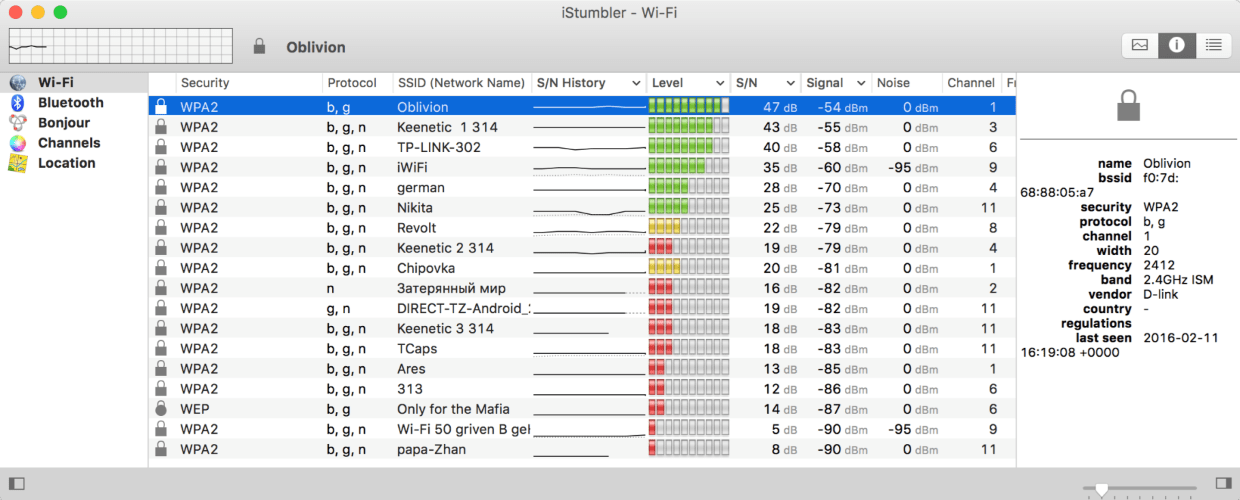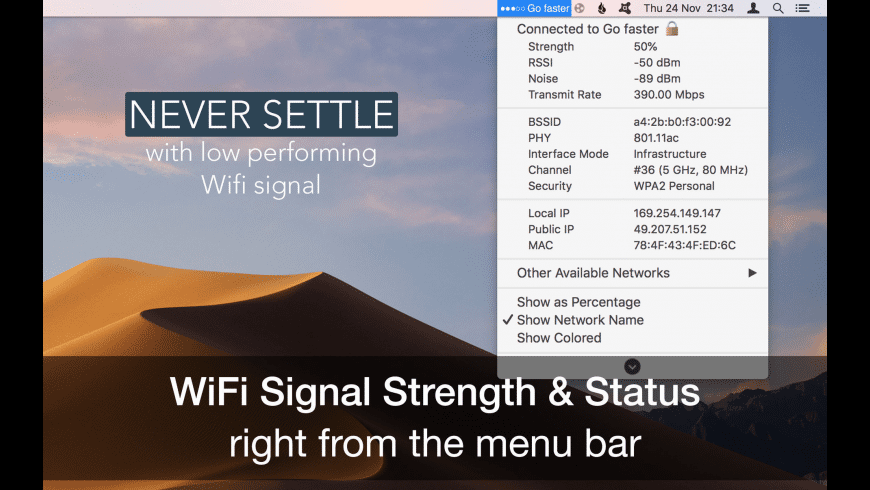Today, one can only imagine what they would do without the internet and WiFi. While wired connections are still pretty much prevalent, nothing really beats the convenience of WiFi and wireless networks are also catching up in terms of speed. In this article, we are going to talk about how you can get the most out of your WiFi network by monitoring the performance of your network and improving it with these Wi-Fi analyzing tools for macOS.
Jan 10, 2020 HELIOS LanTest is a very popular network performance and reliability testing solution for Mac and Windows clients. It is very easy to use within seconds and scales from single local disk testing, to testing performance of a network volume, as well as multi-user concurrent client testing against a single server volume. FileHippo is home to a range of great Mac remote desktop apps, Mac networking tools, private networking and admin tools. Some of our most popular Mac networking apps include TeamViewer, LogMeIn Hamachi, Chicken (a VNC for Mac OS X version 10.4 and above), and Alfred – a handy program which lets you locate applications and files and launch them on your Mac without using your mouse. IStumbler wifi analyzer app for Mac will display networks according to their types, i.e. Bluetooth, Bonjour or AirPort. Thanks to a friendly interface it is easy to see the open networks and secured ones, signal strength of each available network, and the stability of a selected network.
- WiFi Explorer detects 802.11a/b/g/n/ac wireless networks, works with 2.4 and 5GHz channel bands, and 20, 40, 80 and 160 MHz channels. This wifi analyzer tool can keep an eye on network signal strength consistently and provide you with metrics and network details that can be exported to a CSV file.
- Measuring signal strength, channels, MAC addresses and security status of Wi-Fi networks is essential to understanding their health, and here are free tools – some for Windows, some for Macs.
Note: Most of these apps only work with the built-in WiFi adapter of your Mac and do not work with an external adapter.
Also Read: 10 Best WiFi Analyzer for Windows 10/8/7
1. macOS WiFi Analyser
macOS itself comes with a Wireless Diagnostics tool which you can use to scan all available wireless networks and get a summary of all the channels that your device can connect to. From the summary, it is able to suggest the best 2.4 GHz or 5GHz channel or network suitable for you. It can also be used to monitor the network performance, get log information and even as a sniffer to capture WiFi traffic.
To access it, while holding the Option key click on the WiFi icon in the menu bar and you should see an option as “Open Wireless Diagnostics” which should take you to your built-in WiFi analyzer. Or simply you can also open Spotlight Search and type in “Wireless Diagnostics”.
Pros:
- Network Scanner
- Monitor performance of connected WiFi
- Log Info
- Channel Suggestions
Cons:
- Non-intuitive UI
- No graphical representations
Verdict:
You can get away with the Wireless Diagnostics tool if you need to troubleshoot some minor issues in your personal network. Although it is not very powerful, given it comes built-in and free, you can’t really complain.
2. WiFi Signal
WiFi Signal is one of the more simpler apps on this list which provides all the information you need about your wireless network in a compact and elegant card fashion. The app lives on your menu bar, the icon of which can be fully customized and clicking on it gives you everything from the Signal to Noise Ratio (SNR) to the max data rate and MCS index of your connection. There is a real-time graphical representation of the signal rate and noise rate and the app can also recommend the best channel.

Read: Create a WiFi hotspot from Android which is already connected to WiFi
Pros:
- Customizable menubar icon with live signal rate
- Simple at a glance information
- Notifications support
- Channel recommendations
Cons:
- Info of only connected network
- No WiFi scanner
Verdict:
If you are someone who needs to check the strength or quality of your current network from time to time, this app provides you all the info in an elegant card fashion along with a customizable menu bar icon.
Download WiFi Signal ($4.99)
3. WiFi Explorer
WiFi Explorer is one of the highest rated WiFi analyzer apps on the Mac App Store and rightfully so. The app does a great job at scanning, monitoring, and troubleshooting wireless networks.
The app provides various real-time graphs for network details, signal strength, and spectrum which makes it much more intuitive for even a normal person to effectively use the app. Apart from the details of your connected network, the graphs also display all the networks your device can connect to, along with all their details which comes in really handy for choosing the strongest access point for your computer. A bonus feature of this app is that you can save all the results for a later review and even export all the network details as a CSV file.
Pros:
- Graphical visualizations of the WiFi environment
- Detailed descriptions of access points
- Exportable to CSV format
Cons:
- Pricey for the number of features it offers
- No menubar icon
Verdict:
Wi-Fi Explorer is great for quickly identifying channel conflicts, signal overlapping or configuration problems that may be affecting the connectivity and performance of your home, office or enterprise wireless network.
Download WiFi Explorer ($19.99)
4. Wifi Scanner
The next app on our list is WiFi Scanner which adds a number of nifty features to the standard WiFi analysis tool.
Like the previous apps, it comes with various real-time and color co-ordinated graphs of the various available networks and provides details about them. But it doesn’t stop there as WiFi Scanner also brings a built-in WiFi speed testing feature that showcases the ping, download and upload speeds of your network to troubleshoot WiFi networks. There is also an extremely useful IP Scanner feature which will give you a list of all the devices that are connected to your network which is great for finding those WiFi “piggybackers”.
Pros:
- Real time graphs and detailed network parameters
- Speed Testing tool
- IP Scanner
- Exportable to CSV format
Cons:
- No menubar icon or way to quickly glance at any info without opening up the app
Verdict:
Personally to me, WiFi Scanner seems the most bang for your buck and with all its features it functions like an all-in-one from scanning available networks and their performances to seeing which devices are connected to my network.
Download WiFi Scanner ($19.99)
Mocha Pro 5.2 for Mac OS X is the latest version of the most advanced plugin for After effects and Adobe Premiere. Today, many animations are being made and introduced into the market, and the creation of these animations requires a very powerful software to create a highly professional animation with its tools and features. Mocha for after effects macular.
5. NetSpot
NetSpot offers the convenient visual heat maps so you can easily catch any dead spots and how you can optimize access points locations; it is a WiFi analyzer tool like no other!
Mac Strength Lipstick
The app allows you to directly upload a map of your area or draw one using NetSpot’s map drawing tool. Once you have completed that, you can select between several visualizations like signal level, noise level, and access points which show you everything throughout the whole map in the form of heat maps. You can then identify the areas with low signal strength or problems and troubleshoot them.
Pros:
- Full Network analysis and surveys
- Support for area plan or map
- Heat map visualizations
- Suitable for commercial use
Cons:
- Very pricey for personal use
Verdict:

NetSpot feels like a well polished complete WiFi analyzer app. It does feel a little redundant for personal use but with its commercial licensing, it should work great for commercial use or large office areas to detect dead zones and improve the overall connectivity of the area.
Download NetSpot (Freemium)
6. Honorable Mentions
WireShark is an open source and very powerful network analyzer used mainly by network admins and developers. Although it comes with a steep learning curve, it is one of the best packet analyzer apps available. WireShark is also capable of working in monitor mode, thereby letting you see what other devices are browsing/watching on your network. While normally you’d need an external WiFi adapter to these kinds of things, most Macs have a network card that supports monitor mode which overall works out pretty well.
Network Strength For Mac Catalina
JamWiFi is another free little tool which can not only analyze devices connected to your wireless network, but you can also disconnect them from using your WiFi. But it also comes with a downside which is it will also disconnect you and you have to reconnect again.
WiFi Signal Strength Explorer is a handy little utility which unlike the normal WiFi icon, shows you the strength of connection via dots/percent in the menu bar and by clicking it, you can access some basic details about your current network.
Wrapping Up: WiFi Analyser for Mac
So these were the best WiFi analyzer applications available for macOS and here’s a little recap. For casual use or not too deep analysis, the Wireless Diagnostics seem to work just fine. If you need something quick that shows you details about your connected network just from your menubar, check out WiFi Signal. As a WiFi analyzing tool, WiFi Explorer has got everything you might need. However, if you are a sucker for extra features, WiFi Scanner provides the most for your money. For large organizations or commercial purposes, nothing comes close to NetSpot. Did we miss anything? Which one do you use? Let us know in the comments below.
Network Strength For Mac Pro
Read: 10 Step by Step Fix to WiFi Connected But No Internet Access

